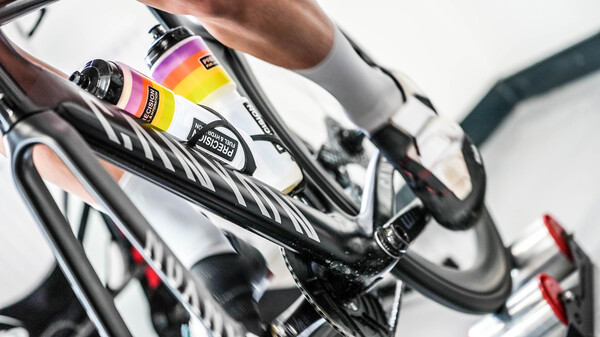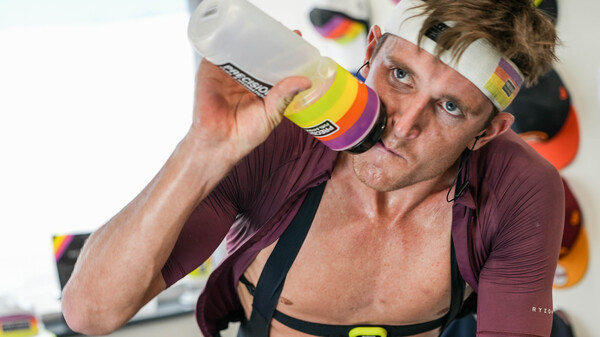What you need to eat and drink during and around training sessions depends largely on the duration, intensity and purpose of your session.
Here are some notes designed to help you home in on what works for you…
Before training
To get the most out of your session, you’ll want to start well fueled and hydrated. Here are some pointers:
Fuel
- Eat a light but carb-dense meal or snack around 2-3 hours before your workout to top off your glycogen stores (your body’s fuel tank)
- If that’s not feasible, then your carbohydrate intake during the session might need to be higher than suggested below (if tolerable), as your ‘fuel tank’ could already be partially depleted
- Taking in a small dose of carbohydrate immediately (10-15 mins) before tougher sessions can deliver additional fuel for the early stages and increase your focus and energy levels. Many athletes will also benefit from some caffeine at this time. Top tip: Eat a gel in the final ~15 mins before you start.
Hydration
- Typically, drinking to thirst throughout the day will be sufficient to start your session hydrated
- But, if you think you’re dehydrated (and you anticipate high sweat losses during the session), you can consume a stronger electrolyte drink (like PH 1500) before you start. We call this ‘preloading’ – here’s the science behind our protocol
- To be clear, you don’t need to preload before every training session. It’s a tactic to get you out of trouble if you’re feeling dehydrated before a particularly long, intense, sweaty session
During training lasting <1 hour
Fuel
- In most cases, if you’re starting well-fueled, you needn’t worry about taking in carbs during activities lasting less than an hour
- But, there’s nuance to consider depending on exactly how long you’re exercising for and at what intensity
- When you’re going for <30 minutes, carbohydrate ingestion has been shown to have little-to-no effect on performance
- For ~45-60 minutes at an “all-out” intensity, then there’s some evidence that your performance may benefit from a small amount (~30g) of easily digestible carbohydrate (i.e. a gel or chew). Or, if you don’t mind mopping up your pain cave afterwards, you could ‘swish and spit’ with a carb mouth rinse!
Hydration
- If you start well-hydrated, you might not need to drink anything during your session
- However, it’s not a bad idea to have some fluid nearby during most activities, (especially if it’s incredibly hot and humid)
- In regards to electrolyte intake, it's highly unlikely that even the heaviest, saltiest sweaters need to worry about sodium replacement in the context of a single, short session

During sessions lasting 1-2 hours
Fuel
- As the duration of your workouts increases, so does the potential upside of consuming more carb. Carbohydrate ingestion will most likely improve your performance for sessions lasting 60-120 minutes
- The target range for this situation is ~30-60g of carbs per hour. This equates to about 500ml-1L (16-32oz) of an isotonic (~6% carb) energy drink, or about 1-2 energy gels or chews per hour
- The longer you’re training and/or the higher your intensity, the more likely it is that erring on the higher end (~60g/h) will be beneficial. This is especially true if you’re training again later that day
Hydration
- This is kind of a ‘twilight zone’ for hydration, as how much fluid and electrolytes you need to consume depends on how much you’re sweating. The ‘optimal’ amount and timing of drinks hinges on your individual sweat rate and exercise conditions (e.g. weather temperature, session intensity, etc). Everyone can tolerate a degree of dehydration without a significant drop in performance, so drinking water to thirst may still suffice here
- Listening to your body is a good start but, as levels of dehydration rise, your performance and thirst signals can be impaired. So if you’re a heavy/salty sweater, it’s a good idea to be more strategic about your intake
During workouts lasting 2+ hours
Fuel
- Beyond 2 hours, research generally points towards a solid dose-response relationship, with higher carb intakes usually eliciting better performance (and recovery)
- So for your longer sessions, you’re likely to benefit from higher intakes of ~60-90g carb per hour, as long as it doesn’t cause gastrointestinal issues (see gut training notes below…)
Hydration
- Training for 2+ hours (especially in hot and/or humid conditions) definitely requires fluid intake to maintain an optimal output. Otherwise, your sweat losses can result in decreased blood volume, presenting as increased heart rate, increased perception of effort and fatigue, GI issues, nausea, and many other unpleasant symptoms!
- Once again, drinking ‘to thirst’ may be sufficient for some athletes, as their accumulated sweat losses could be offset enough by simply drinking when it feels needed
- But, you probably need a more structured approach to drinking if you’re a super heavy sweater, or you're aiming to recover quickly to train or compete again (i.e. in the next 24 hours), or if you’re a novice and not attuned to your body’s signals yet
- In these cases, you can start experimenting with around ~500ml (~16oz) per hour and adjust up or down from there as necessary
- In conditions that drive high sweat rates (i.e. hot weather, high intensity, etc.), sodium replacement can also increase in importance, especially for those with heavy sweat-sodium losses. You already have ‘stores’ of sodium in the body, so complete replacement isn’t necessary, but your intake will be dictated by your sweat sodium concentration and total sweat losses
- This could range from close to zero for those whose sweat/sodium losses are very light, up to something in the 1500mg per litre (~32oz) range for those who experience heavier losses. Experimenting within this range is a sensible place to start if you’re unsure. (Or, book a Sweat Test to understand how 'salty' your sweat is.)

Special considerations
There are exceptions to every rule, and some sessions serve a specific purpose, warranting a special shoutout.
- Race rehearsal. The title speaks for itself. If you’re getting ready to race, you need to practise with exactly what you’re going to eat and drink (and how you’re going to eat and drink it) before, during and after. Just don’t be fooled into thinking that one session constitutes ‘nailing it’. Which brings us nicely on to…
- Gut training. Training your gut to comfortably tolerate and absorb levels of carb intake above ~60g per hour may be a necessary step if you want to optimise your performance in long, hard events. Gradually shifting your consumption upwards from whatever your current tolerable limit is during one or two hard sessions per week over a period of 4-6 weeks seems to be the best approach from those who have tried it successfully in the field. You can dive deeper into how to train your gut HERE. (The same principle applies to consuming more fluid.)
- Carb-restricted training. Some studies have suggested that ‘training low’ (deliberately exercising with low carbohydrate availability) could lead to better long-term performance outcomes (even if performance in a single fasted session is impaired). It’s fair to say that fasted training has split opinion, but this article may help you to decide if it’s right for you
After training
Re-fueling
- It’s important to replace depleted glycogen stores before your next session
- Aim to consume between 1-1.2 grams of carbohydrate per kilogram of body weight per hour (0.45-0.55 grams per pound) during the first ~4 hours after your workout
Rehydration
- You’ll often end up a bit dehydrated by the end of training, which is ok as long as it’s not to a degree that’s negatively affecting your performance
- In most circumstances, rehydrating and replenishing electrolytes through normal food and drink works fine
- You might benefit from a proactive approach to rehydration when you’re doing back-to-back workouts, your sweat losses have been especially high, or you’re training late and have little time to eat and drink afterwards
- In these circumstances, drinking a 500ml (16oz) bottle of a stronger electrolyte drink (like PH 1500) after your session can be beneficial
